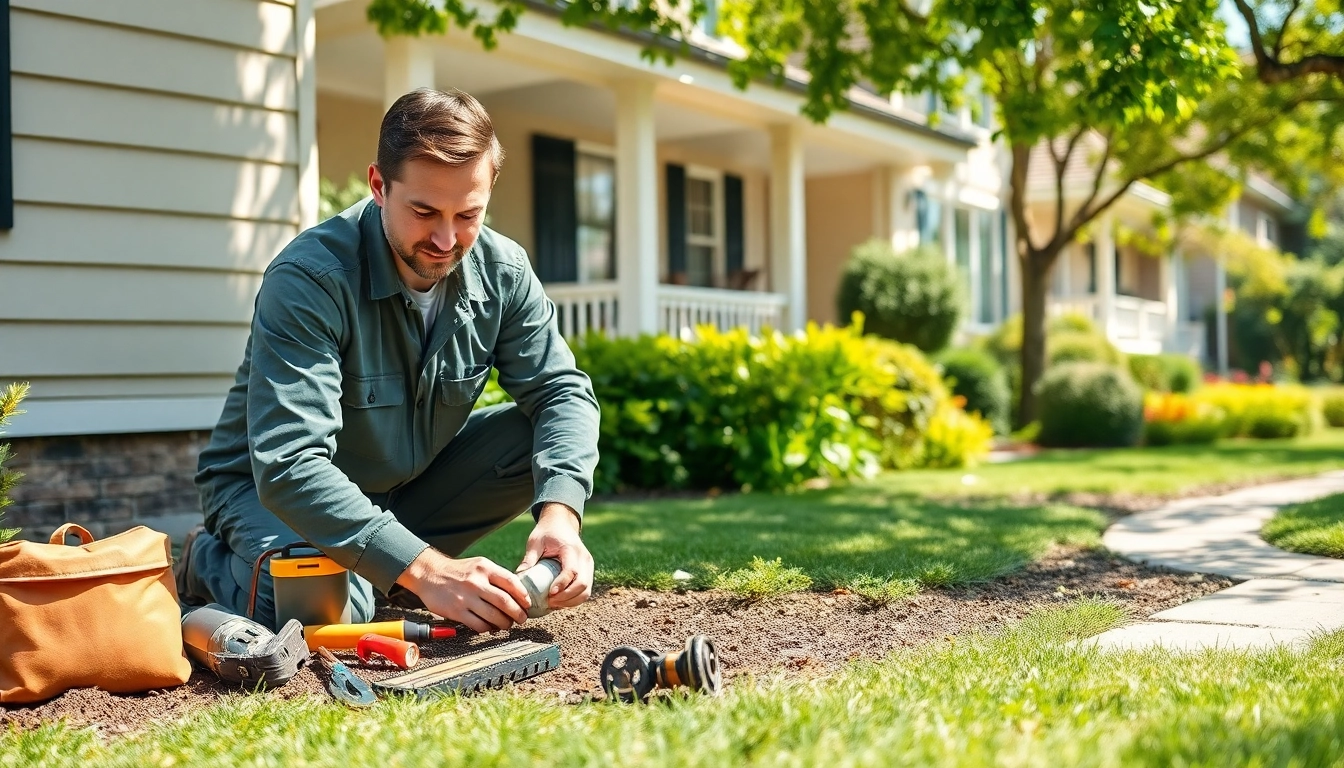Understanding Pest Management: An Overview
Pest management is a critical component of ensuring healthy living environments and safeguarding agricultural outputs. It refers to a comprehensive strategy tailored to manage and regulate pest populations effectively, maintaining their levels at or below those deemed acceptable or tolerable. This concept is especially vital in today’s world, where the interplay between human activity and environmental health is under constant scrutiny. As residents and farmers alike strive for a pest-free existence, understanding the principles and methods of pest management becomes essential.
What is Pest Management?
Pest management encompasses various techniques and strategies employed to control pest populations that may harm human health, property, or agriculture. This systematic approach often combines multiple control methods tailored to specific environments and pest species. Key characteristics of effective pest management include:
- Identification of pest species.
- Assessment of pest populations and associated damage.
- Implementation of control measures, which may be chemical, biological, or cultural.
- Monitoring and evaluation of effectiveness over time.
Ultimately, pest management aims to achieve a sustainable balance between the ecological system and pest populations, ensuring environmental safety and minimal harm to beneficial organisms.
The Importance of Integrated Pest Management
Integrated Pest Management (IPM) is an ecosystem-based strategy that promotes long-term prevention of pests or their damage through a combination of techniques. This method incorporates biological control, habitat manipulation, cultural practices, and resistant varieties to tackle pest problems from multiple angles. The importance of IPM lies in its holistic approach, including the following aspects:
- Environmental Protection: IPM seeks to minimize the impact of pest control activities on the environment and non-target organisms.
- Economic Efficiency: By focusing on the most effective management strategies, IPM reduces unnecessary product use, leading to cost savings.
- Public Health: Addressing pest populations effectively protects human health by preventing disease vectors like rodents and mosquitoes from thriving.
In a time when resistance to chemical pesticides is on the rise, IPM represents a viable alternative that is both effective and sustainable.
Common Types of Pests and Their Impact
Understanding the various types of pests and their potential impacts is crucial in any pest management strategy. Some of the most common pests include:
- Insects: This category includes ants, termites, cockroaches, and mosquitoes, all of which can pose significant health risks and structural damage.
- Rodents: Mice and rats not only contaminate food but can also damage property and spread diseases.
- Weeds: These unwanted plants can compete with crops for resources, reducing agricultural yields significantly.
- Microorganisms: Bacteria, viruses, and fungi can lead to plant diseases, impacting both home gardens and agricultural outputs.
Each pest type requires a tailored approach to effectively manage their populations and mitigate their negative impacts.
Key Principles of Effective Pest Management
Preventive Measures for Homes
Preventive measures are the first line of defense against pest infestations. These strategies aim to make environments less attractive or accessible to pests. Key preventive measures include:
- Seal Entry Points: Regularly inspect your home for gaps and cracks in walls, windows, and doors and seal these off to prevent entry.
- Proper Waste Management: Ensure garbage is disposed of correctly and stored in airtight containers to remove attractants.
- Regular Inspections: Conduct routine checks, especially in areas prone to moisture, to catch early signs of infestations.
- Lawn and Garden Care: Manage landscape carefully to avoid overgrowth that might serve as shelter for pests.
Eco-friendly Pest Control Solutions
As awareness about environmental impacts grows, there is an increasing demand for eco-friendly pest control solutions. These methods emphasize using natural resources and non-toxic products while still providing effective pest management. Examples include:
- Biological Control: Introducing natural predators, such as ladybugs for aphid control, can regulate pest populations without harmful chemicals.
- Botanical Pesticides: Utilizing plant extracts with insecticidal properties, like neem oil, is a safer option for pest control.
- Traps and Barriers: Using non-toxic traps or physical barriers can prevent pests from entering homes or damaging crops.
- Habitat Modification: Adjusting the environment to make it less hospitable to pests can significantly reduce their populations.
Building a Pest Management Plan
A well-defined pest management plan is essential for both home and business owners. The process of building such a plan involves the following steps:
- Assessment: Identify both existing pest problems and potential future pest threats.
- Monitoring: Establish a system for regularly observing pest populations and their effects.
- Strategic Action: Choose appropriate methods based on the specific types of pests and their lifecycle stages.
- Review and Adjust: Monitor the effectiveness of the strategies implemented and make adjustments as necessary.
Challenges in Pest Management
Common Misconceptions About Pest Control
Several misconceptions can undermine effective pest management efforts, including:
- All Pests Are Harmful: While some pests are harmful, others play vital roles in the ecosystem, such as pollination and natural pest control.
- More Pesticide Equals Better Control: Over-reliance on chemical controls can lead to resistance, making pests harder to manage in the long run.
- DIY Solutions Always Work: While some DIY methods can be effective, they may not address the root of the problem without expert intervention.
Addressing these misconceptions through education is key to improving pest management strategies.
Seasonal Pest Trends and Implications
Pest activity can vary considerably based on seasonal changes. Understanding these patterns allows property owners to anticipate potential infestations and take preventative measures:
- Spring: Many pests emerge as temperatures rise, making this a critical time for preventive measures.
- Summer: High humidity creates ideal conditions for insects, leading to increased mosquito and ant activity.
- Fall: Rodents seek shelter indoors as temperatures drop, necessitating checks for entry points.
- Winter: While many pests become dormant, pests like spiders and cockroaches can still invade homes in search of warmth.
Addressing Pesticide Resistance
Pesticide resistance is a significant challenge in pest management today. It occurs when pests develop the ability to survive chemical treatments, often due to overuse or improper application. Addressing this issue requires:
- Diversification of Control Methods: Employing a variety of strategies, including biological control, habitat manipulation, and careful pesticide application, can delay resistance.
- Regular Monitoring: Keeping an eye on pest populations helps identify potential resistance early on.
- Education: Training for both professionals and consumers regarding the proper application and limitations of pest control products can mitigate resistance.
Best Practices for Sustainable Pest Management
Incorporating Cultural Practices
Cultural practices in pest management include changes in agricultural or domestic practices that can reduce pest populations. This can involve:
- Crop Rotation: Rotating crops helps prevent the buildup of pests and diseases related to specific plants.
- Soil Health Management: Healthy soil supports robust plant growth, which can naturally resist pests.
- Water Management: Proper irrigation practices can prevent conditions that foster pest proliferation.
Monitoring and Evaluating Pest Populations
Effective pest management relies heavily on monitoring and evaluation. Regular checks can help determine pest presence and the effectiveness of control measures. Methods include:
- Visual Inspections: Regularly inspecting for signs of pest activity and damage aids in early detection.
- Sticky Traps: These can be placed in strategic areas to capture and monitor pest populations.
- Data Analysis: Keeping records of pest populations and types assists in long-term management planning.
Community Initiatives and Education
Engaging the community is pivotal in creating sustainable pest management practices. Initiatives can include:
- Workshops and Educational Programs: Providing education on pest identification, prevention, and management tactics.
- Community Clean-Up Days: Coordinating events to reduce habitats for pests by cleaning neighborhoods.
- Shared Resources: Developing community programs for resource sharing, such as tools for pest control or equipment for yard maintenance.
Measuring the Success of Pest Management Techniques
Key Performance Indicators in Pest Control
To evaluate the success of pest management efforts, several key performance indicators (KPIs) should be monitored:
- Pest Population Counts: Regular counts can indicate whether populations are declining.
- Area Affected: Measuring the extent of damage over time helps assess the effectiveness of control measures.
- Cost-Effectiveness: Evaluating pest management costs versus the economic benefits gained from successful pest control.
Customer Satisfaction and Feedback
For companies providing pest management services, customer satisfaction is a crucial metric. Conducting surveys and gathering feedback post-service can highlight strengths and areas needing improvement. Effective communication and follow-up can foster trust and enhance customer relationships.
Long-term Benefits of Effective Pest Management
Implementing effective pest management strategies not only provides immediate relief from pest problems but also leads to significant long-term benefits:
- Improved Health Outcomes: Reducing pest populations decreases the risk of pest-related illnesses.
- Economic Savings: Sustainable practices can lower pest control costs over time.
- Environmental Conservation: Reducing reliance on chemical pesticides leads to healthier ecosystems.




